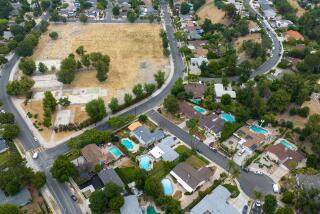Simi Isn’t Buying School Board’s Land Sale Plan
- Share via
SIMI VALLEY — Hoping to make more money on a piece of prime real estate, the school board is seeking to sell a 36-acre lot on Tapo Canyon Road for residential development.
But the proposal, which is subject to approval by city leaders, has again put school officials at odds with their city counterparts.
Several council members would like to see the parcel at Tapo Canyon Road and Alamo Street be developed for residential and commercial uses.
A planning consultant hired by the district, however, told an ad hoc committee of school trustees and city leaders that the land would be more lucrative if it were developed primarily for residential use.
Eric Taylor told the committee at a Wednesday night meeting that developing the lot as commercial property does not serve the district’s needs: to sell the land at the best price.
As a result, the board is deciding whether to seek an amendment to the city’s General Plan and have the land’s designation changed from a low- to medium-density residential area. Board members hope the change might increase the value of the parcel--estimated to be at least $5.5 million--by as much as 50%.
But whether such a change could win the backing of city leaders remains to be seen. The two council members on the ad hoc committee made it clear that they oppose the land being developed primarily for residential use.
Mayor Greg Stratton and others on the council say they would like to see the land have commercial, residential and civic uses.
“I think everyone believes that this should become a hub center of activity for the city and what they’ve proposed won’t lead us to that,” Stratton said during a phone interview Thursday. “And I think they’re going to have some problems with the council.”
District officials, however, say they need to sell the land as soon as possible and at the best price.
With enrollment exceeding expectations, two closed schools may be reopened during the next two years, said Lowell Schultze, assistant superintendent of business services. “If we have to open a school, it’s about a $2-million expenditure to bring it up to state code,” Schultze said. “The school district doesn’t have a lot of money lying around that they could just tap into to open a closed school.”
School board members are committed to maximizing the land’s value, according to board President Janice DiFatta, while also keeping the concerns of the community in mind.
“Our responsibility is to look out for the interest of the school district,” she said. “As such . . . the premium price will come to us if we sell it as residential.”
Stratton remained skeptical that the district’s rush to sell the land would cause it to lose money in the long run.
“If you had to sell your car and you had a car that was worth $4,000 and you were in a hurry and sold it for $2,000, yes, you’d get the cash, but maybe there were other alternatives,” Stratton said.
What to do with the land, now occupied by a fruit stand and crops, has been discussed in the community for several years. Although the school board is scheduled to meet in closed session Sept. 1 to continue its discussions, a resolution is not expected soon.
“It will be two to three years before anybody actually builds anything on that site,” said Taylor, the district’s planning consultant. “It’s a very long, complex process.”
More to Read
Sign up for Essential California
The most important California stories and recommendations in your inbox every morning.
You may occasionally receive promotional content from the Los Angeles Times.













